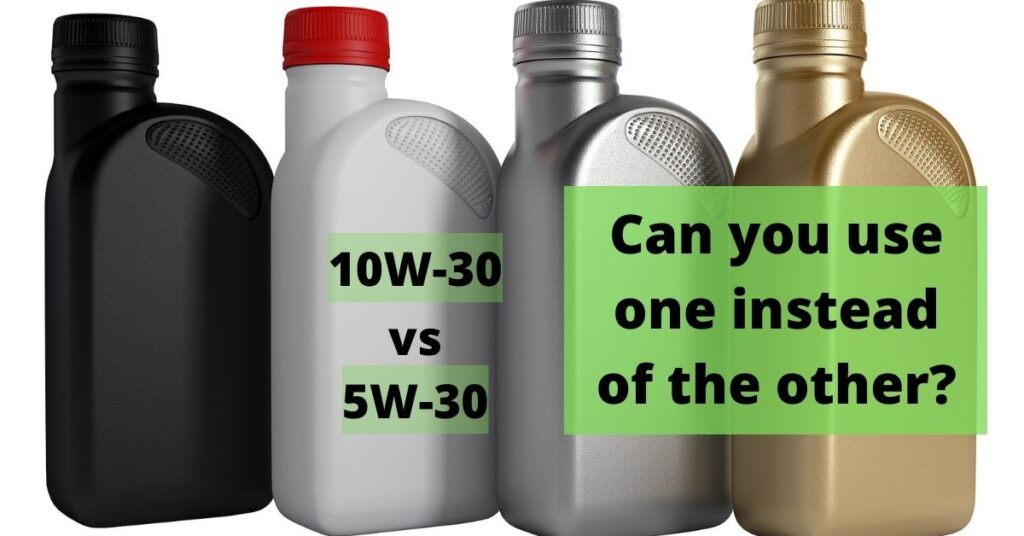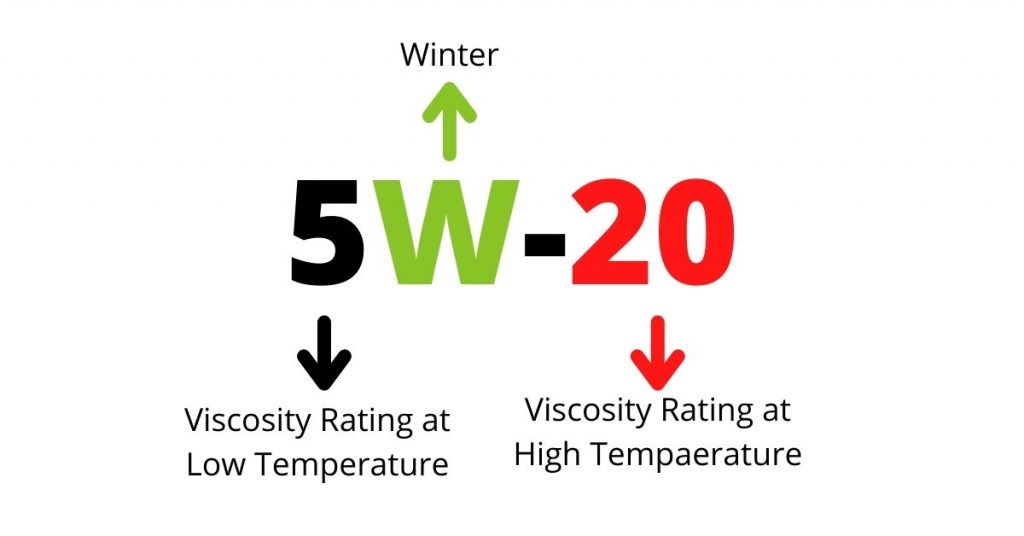So your oil takes SAE 10W-30 engine oil but you want to use 5W-30?
Is that ok? What happens if you do it? What really is the difference between 10W-30 and 5W-30?
This article will take you through all of the answers to your questions. It will discuss the major differences between the two, what the oil rating means, and the dangers of using these oils interchangeably.
But if you don’t want to read the entire article, here’s my best answer:
The best recommendation is to only use the oil type recommended by your owner’s manual. There are engine risks when you use 10W-30 instead of 5W-30. If you choose to use one oil over another, do so at your own risk.
To fully understand this recommendation, read on in the article to really understand the risks of using one oil instead of another.

What does SAE oil rating mean?
Before we discuss the differences between the two oil ratings of discussion: 10W-30 vs 5W-30, we should break down what these ratings mean.
You may hear that these oil ratings are also referred to as weights so if you see or hear that term, it is referring to this number. However, as you will find out soon, this rating does not actually equate to the weights of the different types of oils, so it is slightly misleading.
You will notice that each of these ratings is typically led by the letters SAE. SAE stands for the Society of Automotive Engineers.
The Society of Automotive Engineers has performed testing to classify each type of oil rating.
What they do in these tests is measure viscosity, which is essentially the thickness of a fluid, or how easily it moves. Fluids with higher viscosity are thicker than those with lower viscosity.
SAE performs a test in which they test the oil at various temperatures and then measure the viscosity. Then use these measurements to classify each group. Without getting too technical, there are two main sections of the oil rating.
Engine oils with these two sections are what are referred to as multigrade viscosity motor oils.

The first group is a single or double-digit number (0, 5, 10, 15, 20, 25) that rates the viscosity at lower temperatures. The higher the rating, the more viscous (or thick) the oil is at lower temperatures. This means that for engines starting at cold temperatures, lower numbers tend to perform better than higher numbers.
The second part is the W which stands for “winter”. This is universal between all oils that have this SAE rating. It is meant to separate the two ratings by indicating the number which designates the cold operating performance.
The third group is the number following the W or the “-“. This number is a double-digit rating (20, 30, 40, 50, 60) that rates the viscosity at operating temperatures (or once the engine is warm).
This means that higher numbers here run thicker when an engine has been heated up.
For a good explanation of both viscosity and SAE oil ratings, Engineering Explained does a great job in the video below!
Why do cars use different oil types?
Something that can be difficult to understand is why some oils require certain types of oil. Though the main design of motor engines is similar, there are nuances that may affect efficiency.
Each car and engine manufacturer goes through extensive testing to determine based on the engine design which oil type will be best suited for the engine.
This is based on factors such as:
- efficiency
- engine longevity
- oil longevity
- levels of component protection
What about additives?
Another part of engine oil differences is the additives that may exist in the oil.
Additives are other components that help to minimize the oxidation in the oil, prevent wear, rust and corrosion, and prohibit foam. They are all components that improve the efficiency and longevity of both your engine and the oil that goes in it.
For a full list of oil additives check out this article from Firestone.
Each oil is composed of 5-30% oil additives. This means that the base oil is anywhere between 70-95% of the total volume.
Additives, as mentioned before are already included in the oil. There are additional additives that can be used with oils, but most manufacturers recommend against that.
These additives have varying levels in the type of motor oils. These differences are mainly based on the oil type rather than the oil grade.
This means that full synthetic, synthetic blend, conventional, and high mileage motor oil are likely to have varying levels of these additives regardless of the SAE oil rating.
10W-30 vs 5W-30
So know that we know a bit more about what these ratings mean, let’s talk about the differences and similarities between 10W-30 and 5W-30 engine oils.
| 10W-30 | vs | 5W-30 | |
|---|---|---|---|
| Price | Neither | vs | Neither |
| Better for cold starts | vs | X | |
| Thicker at high temperatures | Neither | vs | Neither |
The differences between these two ratings are quite minimal. Because both have the same viscosity rating of 30, they are comparable at regular operating conditions.
However, the main difference here is that the 5W-30 is better for cold starts than the 10W-30 has because it is thinner at cold temperatures which means it is thinner and provides less resistance in the engine when its cold outside.
An engine that uses an SAE 10W-30 oil grade must, for some reason require thinner fluid in the mechanics and an engine needing SAE 5W-30 requires the thicker oil for better performance.
As mentioned before there are many factors and extensive research and testing that goes into determining the appropriate engine oil for your truck or car.
Technical Specifications
As an engineer myself, I take some interest in describing the technical differences between these types of engine oils.
The information taken from this section compares the metrics provided by the Mobil 1 Datasheet for the 5W-30 and 10W-30 full synthetic oils for reference.
For those not science nerds, the important point to notice here is that at both temperatures, the 5W-30 has a higher viscosity.
There is no data here on extremely cold temperatures, but we would likely see similar measurements.
What this information confirms is that the 5W-30 is in fact thicker than the 10W-30 at warmer temperatures.
The pour point is also an interesting metric because what this information shows is that the thinner oil (10W-30) requires colder temperatures to exhibit the same characteristics of the thicker oil (5W-30).
| 5W-30 | vs | 10W-30 | |
|---|---|---|---|
| Viscosity @ 100 C | 10 mm2/s | vs | 9.9 mm2/s |
| Viscosity @ 40 C | 56.9 mm2/s | vs | 63 mm2/s |
| Flash Point (1) | 235 C | vs | 250 C |
| Pour Point (2) | -42 C | vs | -39 C |
Looking for an oil change?
We have some special offers for our readers for oil changes at Valvoline!
Click each offer below to redeem
Can you use 10W-30 instead of 5W-30?
So the answer you’ve all been waiting for. It is not recommended to use SAE 10W-30 instead of 5W-30. If your truck or car recommends 5W-30, that is the oil you should use.
But what will happen if you use 10W-30 instead of 5W-30?
This change in thickness will not prevent the engine from running, but it will likely decrease the engine efficiency due to the increased resistance in the oil.
Again, long periods of time using a thicker engine oil could cause long-term damage, but in the short term, there will be no extra internal engine friction.
However, if you anticipate driving in frequently cold conditions, this will have a more negative effect if you use 10W-30 instead of 5W-30.
Can you use 5W-30 instead of 10W-30?
So what if you have a car that recommends 10W-30 and you use 5W-30?
Of course, this depends on many factors. Some people are tempted to use thinner oil in their engines to improve efficiency. Engineering Explained states in the video above that a single grade thinner oil *such as this case) can improve fuel and engine efficiency by 0.3-0.5%.
However, what this does to an engine is place thinner oil between the moving parts.
This means that using 5W-30 instead of 10W-30 will increase the friction between engine parts leading to engine damage and decreased oil life.
10W-30 is typically meant for more powerful and larger engines than those with 5W-30 as the recommended oil type. So there could be greater risk for damage switching between the two.
Many manufacturers will recommend that for operation at cold temperatures, most recommendations, especially for Ford tell the user to use a 0W rated oil.
Conclusion
The recommendations provided in your owner’s manual are there for a reason.
Your engine was verified and designed with the specific oil type in mind. There were many factors that went into this decision and shouldn’t be ignored.
The only reasons for which you could ask this question are if you are due for an oil change and your local store is out of stock or you already have some oil in your garage but it doesn’t match the recommendations.
If either of these are true, first ask yourself if changing your oil needs to be replaced right now.
Need help determining how long you can go without an oil change? I walk through everything you need to know in my article: How long to go without an oil change before it’s too late?
Hopefully, you can find the answers you need there to convince you that you likely don’t need to change your oil right now if you are due for regular maintenance. However, if you experience any severe problems, that may not be the case.
I recommend that you take the time to get the oil you need instead of replacing it with a different oil type.
So it is recommended not to use 10W-30 instead of 5W-30.
How to choose the right type of oil?
The first place to start is by looking at your owner’s manual. You will find information here on which type of oil is recommended for your engine.
The manual should also state or mention some type of warranty if a different oil type is used.
In addition, newer cars will have more information on various engine oil types that are recommended for use in various temperatures and may even provide recommendations based on driving conditions.
And the last place where you might find the oil recommended for your engine is on the engine oil cap.





